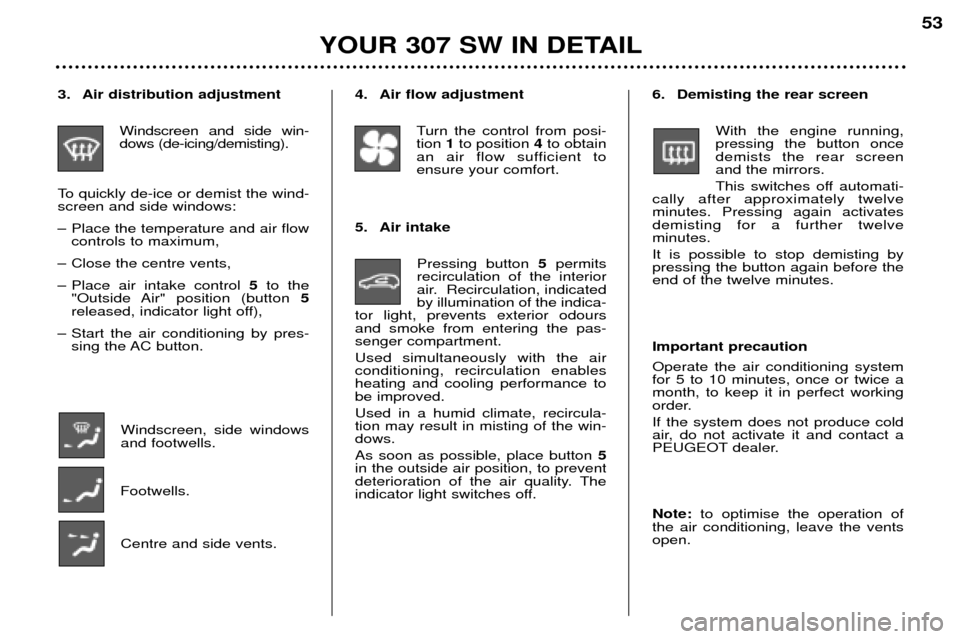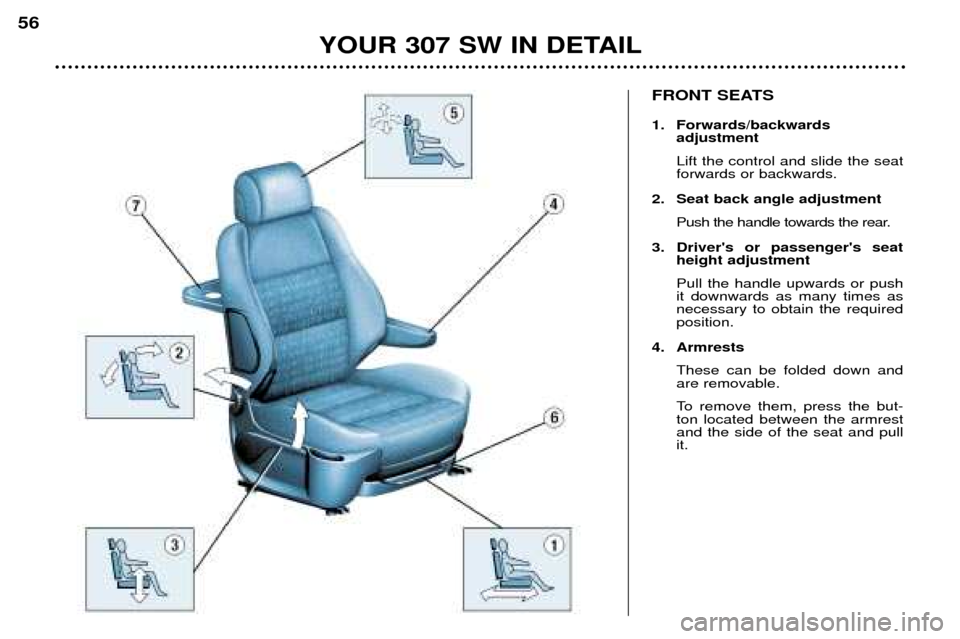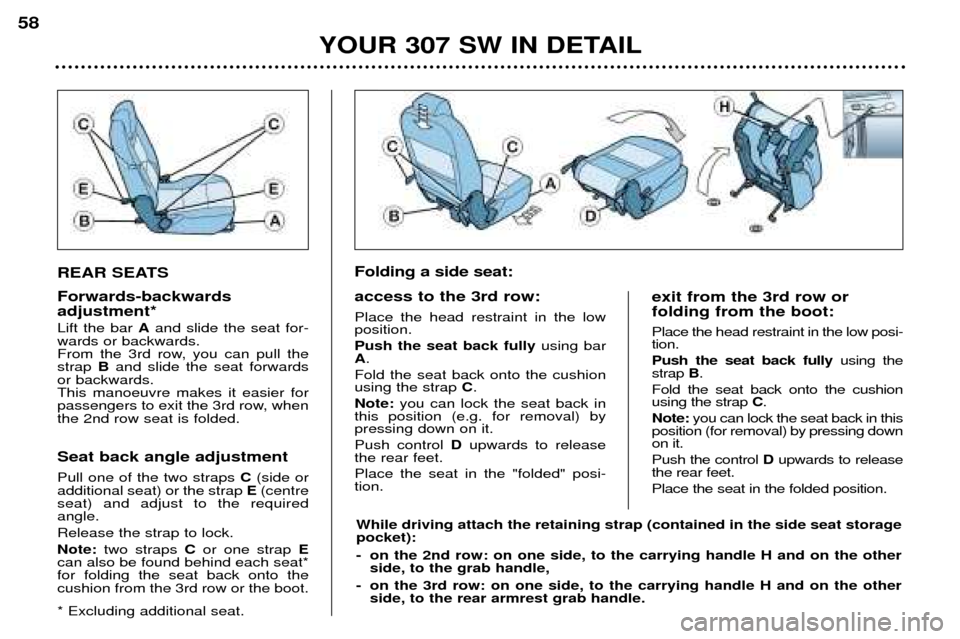Peugeot 307 SW 2002 Workshop Manual
Manufacturer: PEUGEOT, Model Year: 2002, Model line: 307 SW, Model: Peugeot 307 SW 2002Pages: 137, PDF Size: 1.43 MB
Page 51 of 137

YOUR 307 SW IN DETAIL51
VENTILATION 1. Windscreen de-icing or demisting vents.
2. Front window de-icing or demisting vents.
3. Side vents.
4. Centre vents.
5. Air outlet to front footwells.
6. Air outlet to rear footwells.
Advice on operation � Place the air flow control at a level sufficient to ensure correct renewal of air in the passenger compartment. The ''OFF''
position cuts off all the air circulation in the passenger compartment. Note : only use the ' 'OFF''position occasionally (risk of condensation).
� For perfectly even air distribution, take care not to obstruct the exterior air intake grilles, the vents and the air ducts und er
the front seats, as well as the air extractor located in the boot. Check that the pollen filter is in good condition.
Page 52 of 137

YOUR 307 SW IN DETAIL
52
AIR CONDITIONING
1. Air conditioning control The air conditioning is designed to
operate in all seasons. In summer, itenables the temperature to be lowe-
red and in winter, above 0 ¡C, it
increases the effectiveness of thedemisting. Press the switch, the indi-cator light comes on. The air conditioning does not ope-rate while the air flow adjustmentcontrol is in the "OFF" position. Note It is quite normal that the condensa- tion created by the air conditioningresults in a flow of water under the
vehicle when it is stationary.
2. Temperature adjustment
To be adjusted to your requirements.
Page 53 of 137

YOUR 307 SW IN DETAIL53
4. Air flow adjustment Turn the control from posi- tion 1to position 4to obtain
an air flow sufficient toensure your comfort.
5. Air intake Pressing button 5permits
recirculation of the interior
air. Recirculation, indicatedby illumination of the indica-
tor light, prevents exterior odoursand smoke from entering the pas-senger compartment. Used simultaneously with the air conditioning, recirculation enablesheating and cooling performance tobe improved. Used in a humid climate, recircula- tion may result in misting of the win-dows. As soon as possible, place button 5
in the outside air position, to prevent
deterioration of the air quality. The
indicator light switches off.
3. Air distribution adjustment
Windscreen and side win-dows (de-icing/demisting).
To quickly de-ice or demist the wind-screen and side windows:
Ð Place the temperature and air flow controls to maximum,
Ð Close the centre vents,
Ð Place air intake control 5to the
"Outside Air" position (button 5
released, indicator light off),
Ð Start the air conditioning by pres- sing the AC button.
Windscreen, side windows and footwells.
Footwells.
Centre and side vents. 6. Demisting the rear screen
With the engine running,pressing the button oncedemists the rear screenand the mirrors.
This switches off automati-
cally after approximately twelve minutes. Pressing again activatesdemisting for a further twelveminutes. It is possible to stop demisting by pressing the button again before theend of the twelve minutes. Important precaution Operate the air conditioning system for 5 to 10 minutes, once or twice amonth, to keep it in perfect working
order. If the system does not produce cold
air, do not activate it and contact a
PEUGEOT dealer. Note: to optimise the operation of
the air conditioning, leave the vents open.
Page 54 of 137

YOUR 307 SW IN DETAIL
54
AUTOMATIC AIR CONDITIONING
Automatic operation
1. Temperature adjustment The chosen temperature is displayed. Press the upand down arrows to chan-
ge it. A setting around 21 ¡C enables a comfor-table temperature to beobtained. 2. Automatic comfort
programme
Press the "AUTO" button.The system automaticallyadjusts the atmosphereinside the vehicle in accor-
dance with the chosen temperature.
To do this, it controls the temperatu-
re, the flow, the distribution and theintake of air as well as the air condi-tioning. 3. Automatic visibility
programme
In some cases, the automa-tic comfort programme may
not be sufficient for de-icingor demisting of the windows
(humidity, several passengers, iceetc.). In this case, select the automatic visibility programme to clear the win-
dows quickly.
Page 55 of 137

Manual operation
If you wish, you can make a different
choice from that offered by the sys-
tem by changing a setting. The otherfunctions will still be controlled auto-
matically. Pressing the "AUTO" but-ton returns the system to completelyautomatic operation.
4. Air conditioningPress this button to switch
off the air conditioning. Thesymbol "ECO" is displayed.Automatic operation of the
air conditioning is resumed when the
button is pressed again. The symbol"A/C" is displayed. Note It is quite normal that the condensa- tion created by the air conditioningresults in a flow of water under the
vehicle when it is stationary.
5. Air distribution
Pressing this button several times in successionenables the air flow to bedirected in turn towards:
Ð the windscreen (de-icing or demis- ting), Ð the windscreen and the footwells,
Ð the footwells,
Ð the centre and side vents and the
footwells,
Ð the centre and side vents.
6. Air flow
The flow of air can be increased or reducedby pressing buttons +
or - respectively.
7. Air intake Press this button to enablethe interior air to be recir-culated. Recirculation,
shown on the display,
enables the passenger compartmentto be insulated from exterior odoursand smoke.
Avoid prolonged recirculation of
interior air. To do this, press the but-ton again to resume intake of exte-
rior air. 8. Switching the system off
The "OFF" button enablesthe entire system to be swit-
ched off.
9. Demisting the rear screen Press this button to demistthe rear screen and the mir-
rors. Demisting switches off
automatically. It is possibleto stop operation of the
demisting before it is switched offautomatically by pressing the buttonagain.
Important precaution Operate the air conditioning for 5 to 10 minutes, once or twice a month,
to keep it in good working order. If the system does not produce cold
air, do not use it and contact your
PEUGEOT dealer. Note: to optimise the operation of
the air conditioning, leave the vents open.
YOUR 307 SW IN DETAIL 55
Page 56 of 137

FRONT SEATS
1. Forwards/backwards adjustment Lift the control and slide the seat forwards or backwards.
2. Seat back angle adjustment Push the handle towards the rear.
3. Driver's or passenger's seat height adjustment Pull the handle upwards or push it downwards as many times asnecessary to obtain the requiredposition.
4. Armrests These can be folded down andare removable.
To remove them, press the but- ton located between the armrestand the side of the seat and pullit.
YOUR 307 SW IN DETAIL
56
Page 57 of 137

Never drive with the head restraints removed; theyshould be in place andcorrectly adjusted.
5. Head restraint height andangle adjustment
To raise or lower the restraint, pull it forwards, sliding it at thesame time.
To remove the head restraint, place it in the top position, lift thelug using a coin and pull it for-wards and upwards at the sametime.
To put it back in position, locate the stems of the restraint in theholes, taking care to keep themin line with the seat back.
Active seat back (front seat)
This possesses a device to prevent"whiplash". When there is an impact from the
rear, the action of the body on theseat back forces the head restraintforwards and upwards, preventingthe head being thrown backwards. 6. Storage drawers There is a storage drawer under each front seat.
Ð To open it, lift it and pull.
Ð To take it out, open it to its full
extent, press the ends of the slides
and lift it, then remove it completely.
Do not place heavy objects in thedrawers. Under the front passenger seat, the layout of the floor allows for storageof a first aid kit and a warning triangle(small version).
7. "Aviation" style table There is an "aviation" style table,
fitted with a can holder, at the rear ofeach front seat.. REAR HEAD RESTRAINTS These have a high position for when they are in use and a low position forwhen they are stored. The head restraints are also remo- vable.
To remove them, pull upwards as far as the stop, then press the lug (sideseat) or on the two lugs (centreseat).
YOUR 307 SW IN DETAIL
57
The adjustment is correct when the upper edge of thehead restraint is level withthe top of the head.
Page 58 of 137

Never drive with the head restraints removed; theyshould be in place andcorrectly adjusted.
5. Head restraint height andangle adjustment
To raise or lower the restraint, pull it forwards, sliding it at thesame time.
To remove the head restraint, place it in the top position, lift thelug using a coin and pull it for-wards and upwards at the sametime.
To put it back in position, locate the stems of the restraint in theholes, taking care to keep themin line with the seat back.
Active seat back (front seat)
This possesses a device to prevent"whiplash". When there is an impact from the
rear, the action of the body on theseat back forces the head restraintforwards and upwards, preventingthe head being thrown backwards. 6. Storage drawers There is a storage drawer under each front seat.
Ð To open it, lift it and pull.
Ð To take it out, open it to its full
extent, press the ends of the slides
and lift it, then remove it completely.
Do not place heavy objects in thedrawers. Under the front passenger seat, the layout of the floor allows for storageof a first aid kit and a warning triangle(small version).
7. "Aviation" style table There is an "aviation" style table,
fitted with a can holder, at the rear ofeach front seat.. REAR HEAD RESTRAINTS These have a high position for when they are in use and a low position forwhen they are stored. The head restraints are also remo- vable.
To remove them, pull upwards as far as the stop, then press the lug (sideseat) or on the two lugs (centreseat).
YOUR 307 SW IN DETAIL
57
The adjustment is correct when the upper edge of thehead restraint is level withthe top of the head.
Page 59 of 137

REAR SEATS Forwards-backwards adjustment* Lift the bar Aand slide the seat for-
wards or backwards.
From the 3rd row, you can pull thestrap Band slide the seat forwards
or backwards.This manoeuvre makes it easier for
passengers to exit the 3rd row, whenthe 2nd row seat is folded.
Seat back angle adjustment Pull one of the two straps C(side or
additional seat) or the strap E(centre
seat) and adjust to the required angle. Release the strap to lock.Note: two straps Cor one strap E
can also be found behind each seat* for folding the seat back onto thecushion from the 3rd row or the boot. * Excluding additional seat. Folding a side seat: access to the 3rd row: Place the head restraint in the low position. Push the seat back fully
using bar
A .
Fold the seat back onto the cushion using the strap C.
Note: you can lock the seat back in
this position (e.g. for removal) bypressing down on it. Push control Dupwards to release
the rear feet.Place the seat in the "folded" posi- tion. exit from the 3rd row or folding from the boot: Place the head restraint in the low posi- tion. Push the seat back fully
using the
strap B.
Fold the seat back onto the cushion using the strap C.
Note: you can lock the seat back in this
position (for removal) by pressing downon it. Push the control Dupwards to release
the rear feet.Place the seat in the folded position.
YOUR 307 SW IN DETAIL
58
While driving attach the retaining strap (contained in the side seat storage pocket):
- on the 2nd row: on one side, to the carrying handle H and on the other
side, to the grab handle,
- on the 3rd row: on one side, to the carrying handle H and on the other side, to the rear armrest grab handle.
Page 60 of 137

YOUR 307 SW IN DETAIL59
Centre seat table position Place the head restraint in the low position. Fold the seat back onto the cushion using the strap E.
You now have a small table with fourcan holders, two pen holders and a
document holder.
Folding the centre seat Place the head restraint in the low position. Push the seat back full y using the
bar A.
Fold the seat back onto the cushion using the strap E.
Note: you can lock the seat back in
this position (for removal) by pres-sing down on it. Push control Dupwards to release
the rear feet.Place the seat in the folded position. While driving, attach the retaining strap (contained in the storagepocket of one of the front seats)on one side, to the carrying hand-le H and on the other side, to thegrab handle. Folding an additional seat Place the head restraint in the low position. Fold the seat back onto the cushion sliding the strap
C downwards, then
pulling it forwards or backwards. Note: you can lock the seat back in
this position (for removal) by pres- sing down on it. Push the two levers Fupwards to
unlock the rear feet.Place the seat in the folded position. While driving, attach the retaining strap (contained in the storagepocket of the additional seat) onone side, to the carrying handle H
and on the other, to the rear arm-rest grab handle.